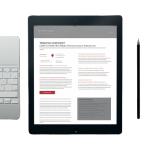
The food and beverage (F&B) industry has seen its fair share of challenges and transformations in recent years, with technology playing a pivotal role. As Senior Director, Commercial and Operations Systems at Loews Hotels, Barry Phillips witnessed firsthand how technology has both enhanced and reshaped the way F&B services are delivered. In this article, a follow-up to our recent Shiji Buzz webinar, Barry shares the top challenges facing hotel F&B departments today and delves into three critical areas of evolution in food and beverage technology: digital menus, the virtualization of the front desk, and the automation of F&B services.
Barry’s Key Insights
- Hotel F&B departments must strike a balance between technology enhancements for guests and the adoption of technology by team members to provide hyper-personalized experiences.
- Digital menus are not a temporary trend; they are a permanent fixture in the F&B industry, offering convenience to guests while requiring consistency and relevance in menu offerings.
- The virtualization of the front desk and the automation of F&B services should be tailored to align with brand identity and guest preferences, maintaining a harmonious blend of technology and personalized service.
Challenges in Hotel F&B
One of the primary challenges faced by hotel F&B departments today is striking the right balance between technology and the human touch. Technology enhancements for guests are vital, but so is the adoption and adaptation of these technologies by team members. Our team members are our most valuable assets, and we must leverage data and technology not only to drive efficiency but also to provide hyper-personalized experiences to our guests. Post-pandemic, we have witnessed a surge in technology adoption, but it’s essential to fine-tune and evaluate how it aligns with the evolving needs of both guests and team members. The pandemic accelerated innovation in the F&B industry by a decade, emphasizing the need to continue embracing technology while maintaining a human touch.
Digital Menus: Here to Stay
Digital menus are not a mere pandemic-era trend; they are here to stay. Modern consumers desire the ability to review menus in advance and opt for contactless dining experiences. Digital menus fulfill these needs. However, we can expect refinement in how digital menus are utilized within different segments and markets. Contactless dining is no longer solely a luxury but also an economically feasible option. The future lies in the blend of physical and digital menus. For instance, combining physical menus with QR codes allows us to display staples and real-time specials, enhancing guest satisfaction. However, the challenge lies in ensuring the consistency and relevance of menu items and pricing, which varies across brands and operational models. Owner-operators have an advantage here in maintaining consistency and streamlining the tech stack.
Virtualization of the Front Desk: Finding the Balance
The front desk is increasingly going virtual, and F&B is not far behind. The extent to which F&B should automate services depends on the brand and guest preferences. While some brands emphasize a physical, in-person experience, others embrace virtualization. The level of virtualization will define how guests interact with a brand, impacting their perception positively or negatively. In the luxury segment, the human touch remains essential, and complete automation may not align with the expectations of luxury travelers. However, for mid-luxury to luxury brands, there is room for balance. Services like in-room dining can offer options for a high-touch or contactless experience based on guest preferences. Today’s guests have the flexibility to self-order, self-book, and even have their meals delivered without human interaction. The future will depend on how brands define this balance, unlocking new possibilities while maintaining a harmonious blend of technology and personal service.
Conclusion
The challenges and opportunities in hotel F&B today revolve around technology and its integration into the guest experience. We must navigate the delicate balance between tech-driven efficiency and personalized service. Digital menus are here to stay, offering guests the convenience they seek while demanding consistency and relevance. The virtualization of the front desk is an ongoing journey, with each brand finding its unique balance between human interaction and automation. The future of hotel F&B lies in embracing technology while never losing sight of the human element, ensuring that our guests receive the best of both worlds—an efficient, personalized, and memorable dining experience.
RELATED:





